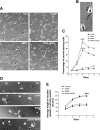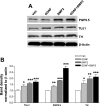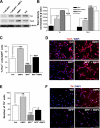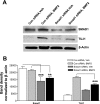BMP2 promotes differentiation of nitrergic and catecholaminergic enteric neurons through a Smad1-dependent pathway
- PMID: 20007850
- PMCID: PMC2838511
- DOI: 10.1152/ajpgi.00343.2009
BMP2 promotes differentiation of nitrergic and catecholaminergic enteric neurons through a Smad1-dependent pathway
Abstract
The bone morphogenetic protein (BMP) family is a class of transforming growth factor (TGF-beta) superfamily molecules that have been implicated in neuronal differentiation. We studied the effects of BMP2 and glial cell line-derived neurotrophic factor (GDNF) on inducing differentiation of enteric neurons and the signal transduction pathways involved. Studies were performed using a novel murine fetal enteric neuronal cell line (IM-FEN) and primary enteric neurons. Enteric neurons were cultured in the presence of vehicle, GDNF (100 ng/ml), BMP2 (10 ng/ml), or both (GDNF + BMP2), and differentiation was assessed by neurite length, markers of neuronal differentiation (neurofilament medium polypeptide and beta-III-tubulin), and neurotransmitter expression [neuropeptide Y (NPY), neuronal nitric oxide synthase (nNOS), tyrosine hydroxylase (TH), choline acetyltransferase (ChAT) and Substance P]. BMP2 increased the differentiation of enteric neurons compared with vehicle and GDNF-treated neurons (P < 0.001). BMP2 increased the expression of the mature neuronal markers (P < 0.05). BMP2 promoted differentiation of NPY-, nNOS-, and TH-expressing neurons (P < 0.001) but had no effect on the expression of cholinergic neurons (ChAT, Substance P). Neurons cultured in the presence of BMP2 have higher numbers of TH-expressing neurons after exposure to 1-methyl 4-phenylpyridinium (MPP(+)) compared with those cultured with MPP(+) alone (P < 0.01). The Smad signal transduction pathway has been implicated in TGF-beta signaling. BMP2 induced phosphorylation of Smad1, and the effects of BMP2 on differentiation of enteric neurons were significantly reduced in the presence of Smad1 siRNA, implicating the role of Smad1 in BMP2-induced differentiation. The effects of BMP2 on catecholaminergic neurons may have therapeutic implications in gastrointestinal motility disturbances.
Figures








References
-
- Anderson RB, Newgreen DF, Young HM. Neural crest and the development of the enteric nervous system. Adv Exp Med Biol 589: 181–196, 2006 - PubMed
-
- Benavides-Piccione R, DeFelipe J. Different populations of tyrosine-hydroxylase-immunoreactive neurons defined by differential expression of nitric oxide synthase in the human temporal cortex. Cereb Cortex 13: 297–307, 2003 - PubMed
Publication types
MeSH terms
Substances
Grants and funding
LinkOut - more resources
Full Text Sources
Molecular Biology Databases
Miscellaneous

